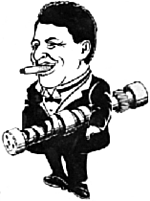|
|
|||||
|
|||||
Ron, I've got a 3000 lb '56 Chevy four door bracket car. It runs consistent 12.50's with a big block, single four barrel, powerglide, nine inch slicks and a hydraulic cam. I want to go a little quicker, so I am considering putting in a hydraulic roller cam. I want to stay with a hydraulic cam because as a bracket racer I don't have time to stop and do any maintenance between rounds. My question is, will a hydraulic roller cam make more power than the non-roller hydraulic? Will the motor rpm higher with a hydraulic roller? Are there any drawbacks to using a hydraulic cam? Finally, the motor is a 427 inch big block with about 10-1 compression, headers, MSD ignition, etc. Can you recommend a grind that would help me get a couple of tenths? Thanks for the info. A.J. Araiza
Your question about a Hydraulic Roller Cam for your '56 Chevy is a good one. Hydraulic Roller Cams (as do Mechanical Roller Cams) have an important advantage over their flat tappet Hydraulic & Mechanical cousins. Their maximum velocity (max rate of lift per degree of camshaft rotation) is not limited by the available lifter diameter. You'd wear out a flat tappet cam trying to make it as radical as a roller simply because the lobe would be trying to reach out over the edge of the lifter! These higher lifter rates translate into more potential area under the lift curve and subsequently more power. Quicker lift rates can also result in lower "seat to seat" duration numbers and somewhat improved throttle response in the lower and mid RPM ranges. All this is very well and good, however, it comes at a price. Hydraulic roller cam kits are roughly 3 times the cost of a comparable flat tappet hydraulic cam kit and have one other potential area of concern, RPM. Those quicker rates of lift demand higher spring loads (increased pressures) to keep the valve train out of "float". Sometimes this can be remedied as in the case of a small block Chevy, with the aid of Camfather Ed Isky's invention of the 1950's, the "Ultra Rev Kit" or "Rev Kit" as it is known as today. Small blocks can usually benefit some 400 - 600 RPM or more with the aid of a Rev-Kit, and the Rev-Kit is preferable to simply adding more valve spring pressure because the latter increases the load on the hydraulic piston assembly, and this can lead to quicker leak down (bleed off) rates which are in themselves RPM limiting. Big Blocks however are another matter. Because of their canted valves and subsequently severe pushrod angles coming out of the lifters (especially on the exhaust side) it has always been a difficult proposition to construct a Rev-Kit for a "Rat Motor" that would be in the long run a trouble free installation. Usually they entail the use of a spring and retainer affixed via keepers to a grooved pushrod. If a conventional Rev-Kit has acquired the reputation for being difficult to install, it is not hard to understand why most people feel thumbs down about these. Where does this leave you, A.J,. regarding your big block? Depending on valve spring loads and how aggressive the hydraulic roller cam is (extreme cases in a big block have been known to float at roughly 5900-6000 rpm) you could conceivably get a maximum of 6200 - 6400 Rpm out of your installation. On the other hand, you could with the proper valve train (i.e. Properly dampened dual Valve Springs & Isky Anti-Pump Up Hydraulic Lifters) achieve 6800 - 7000 Rpm or possibly higher with a flat tappet Mega Hydraulic Series cam. You didn't mention what your rear axle ratio was, but personally, unless you are content to conservatively limit the RPM of your motor to say 6200 revs, (and if you're running 12.50's in the quarter mile, I doubt you are) I'd say don't waste your time or your money with a roller hydraulic cam, because it probably won't do better for you overall. Finally, I asked the Camfather for his take on this situation and here is what Mr. Isky himself had to say: "Hydraulic Roller Cams? Unless you're concerned about the potential for cam lobe wear, you can get all you need in most cases with a flat tappet hydraulic cam." Enough Already! |
|||||
|
Copyright 1999-2001, Drag Racing Online and Racing Net Source |
|||||



